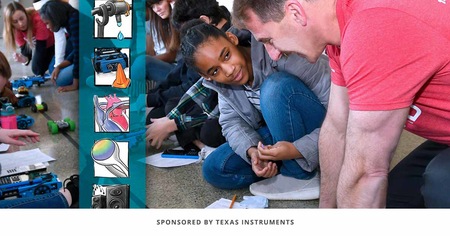Do you think that young people today have too much screen time?
Obviously, the framing of these questions casts a negative light on the recent influx of screens and digital media into the lives of our young people. However, the struggle to find the right balance for screen time is causing a lot of stress in homes and schools across the nation. In a recent survey, screen time was the No. 1 cause of anxiety for mothers ages 35 to 45.
We are in the midst of an information revolution every bit as powerful as the industrial revolution was nearly 200 hundred years ago. The world has changed—and this change is being felt keenly in the childhoods of our young people. From the 3-year-old who stabs frustratingly at a magazine page because it's not working like a tablet, to elementary students who devour YouTube and want to be YouTube stars, to high-schoolers whose social standing rises and falls with ebb and flow of social media ... Pandora's box is open. There is a screen in every pocket; the old model of consuming content together on a schedule is gone.
How can afterschool programs handle screen time—and what advice or guidance can we provide for our young people and their parents?
Regrettably, our instincts on this matter are not helpful. Everyone tends to remember his or her own childhoods fondly. The best childhood is the kind you had; after all, it made you who you are today. Beyond communal televisions, most of us did not have a lot of experience with screens in our childhoods, making us biased when considering screen time. Our experiences tell us young people need to be active, play outside and use their imaginations more—and any screen time is bad for the body and the mind.
Yet consider how much of our young people's future will involve mastering screens and the information they provide.
Where is the right balance?
The official guidelines for young people and screen time were set in 2016, by the American Academy of Pediatrics (AAP):
- For children younger than 18 months, avoid use of screen media other than video chatting. Parents of children ages 18 to 24 months, who want to introduce digital media, should choose high-quality programming and watch it with their children to help them understand what they're seeing.
- For children ages 2 to 5 years, limit screen use to one hour per day of high-quality programs. Parents should co-view media with children to help them understand what they are seeing and apply it to the world around them.
- For children ages 6 and older, place consistent limits on the time spent using media and the types, and make sure media does not take the place of adequate sleep, physical activity and other behaviors essential to health.
- Designate media-free times together, such as dinner or driving, as well as media-free locations at home, such as bedrooms.
- Have ongoing communication about online citizenship and safety, including treating others with respect online and offline.
These guidelines are increasingly coming under fire as being out-of-date and too restrictive. This year, research from the Oxford Internet Institute and Cardiff University looked at the APP guidelines and found no consistent correlations between the advised digital usage limits and young children's well-being. They found there is little or no support for the theory that digital screen use on its own is bad for young children's psychological well-being. This new research concluded that the AAP guidelines are out-of-date and based on research that was conducted long before digital devices had become so ingrained in everyday life.
The reality facing young people today is that screens and digital media have become a part of everyone's daily life. They can help work get done and can be great teaching tools, but like most things can have negative consequences if overused. They can be used to waste time, hide from responsibility, cause eyestrain, disturb sleep patterns and make people more closed off and sedentary.
We want our young people to grow up healthy, with a range of interests. We also want them to be prepared for the world that they will grow up into.
Ultimately, "How much screen time is too much screen time?" has become the wrong question to ask.
Instead, what our young people do with their screen time and how its consumption is part of a healthy well-rounded life is a lot more important.
Instead of blanket restrictions, we need to understand and guide the use of these new tools. We have to look beyond the time spent on screens and look at how that time is being spent.
Not all screen time is created equal. Take, for example, the research that has shown that avid elementary and middle school Mine Craft players read two grades above their grade level. This is surprising, as Mine Craft is a language-free game with no instructions. The no-instruction part is important: Without instructions, Mine Craft players are motivated to seek out guides on how to progress in the game. This motivation led to scores of young people seeking out above-grade reading challenges and persevering with their comprehension, so they could improve their skills.
Instead of demonizing screen time, we need to integrate it into our young people's lives so it becomes a useful skill they can benefit from throughout their lives. Instead of struggling to constantly minimize screen time, we need to work with our young people to craft digital media plans that foster a balanced approach to life and create well-rounded individuals.
Creating a Digital Media Plan
Set clear limits and be consistent. Screen time is a complicated issue; neither an outright ban nor unlimited screen time is the right course. Include your young people as part of the process. Discuss and agree on an appropriate amount of time they can use their devices.
Discuss screen time as a group. Why do your young people want screen time? Is there a reason, or is it just out of habit? Spend time to know and understand what your young people are doing with their screens. Read up on the computer games they play or want. Discuss what they are doing with their screen time and why they like it. Take the time to join in and share their interest. Be involved.
Be open about why you are creating screen time limits. Discuss the positive and negative aspects of electronics and the internet. Understanding why you have concerns about screen time is crucial to teaching young people to regulate themselves. Where age-appropriate, discuss some of the pitfalls hidden in our devices, such as the violence in games, bullying, sexting and social media.
Set up a schedule. Outline clear times and days for electronic device use. When building a schedule, take into account the purpose that the device is being used for. Encourage breaks and make sure to schedule quiet time—such as unwinding before bed. Structure school and vacation time with different rules. Allow for an occasional binge day. By building in too much scarcity, you artificially make these activities more enticing. Allowing for the odd binge can help your young people realize they would rather be doing something else.
Schedule specific times or days when screens are off-limits. For example, until homework is done, until after dinner or when friends are visiting. This helps your young people understand that electronics are just not appropriate at certain times.
Allow for flexibility. As your young people grow and technology changes, you may need to make or modify your digital media plan to account for the changes.
Create screen-free zones of the house. For example, the bedrooms or the dinner table.
Encourage variety and provide alternative activities. Plan fun activities that distract from technology, such as playdates, sports, hiking, museums, reading, board games or hands-on toys.
Set a good example. If phones are away for meal times, they should be away for everyone.
Young people will model their behavior on you. Make sure you're not the one glued to a screen at every opportunity.
Written by Andy the Science Wiz, NAA's STEM specialist, Andy Allan.




